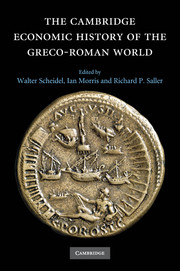Book contents
- Frontmatter
- 1 Introduction
- Part I Determinants of Economic Performance
- Part II Early Mediterranean Economies and the Near East
- Part III Classical Greece
- Part IV The Hellenistic States
- Part V Early Italy and the Roman Republic
- Part VI The Early Roman Empire
- 20 The Early Roman Empire: Production
- 21 The Early Roman Empire: Distribution
- 22 The Early Roman Empire: Consumption
- 23 The Early Roman Empire: The State and the Economy
- Part VII Regional Development in the Roman Empire
- Part VIII Epilogue
- Bibliography
- Index
- Map 1.1 The Mediterranean basin"
- Map 10.1 Greek and Phoenician trade in the period of the Persian Wars"
- Map 11.1 The Achaemenid empire"
- Map 12.1 Greece and Asia Minor"
- Map 15.1 The Seleucid empire"
- Map 16.1 Greco-Roman Egypt"
- Map 20.1 The Roman empire at the accession of Vespasian"
- References
21 - The Early Roman Empire: Distribution
from Part VI - The Early Roman Empire
Published online by Cambridge University Press: 28 March 2008
- Frontmatter
- 1 Introduction
- Part I Determinants of Economic Performance
- Part II Early Mediterranean Economies and the Near East
- Part III Classical Greece
- Part IV The Hellenistic States
- Part V Early Italy and the Roman Republic
- Part VI The Early Roman Empire
- 20 The Early Roman Empire: Production
- 21 The Early Roman Empire: Distribution
- 22 The Early Roman Empire: Consumption
- 23 The Early Roman Empire: The State and the Economy
- Part VII Regional Development in the Roman Empire
- Part VIII Epilogue
- Bibliography
- Index
- Map 1.1 The Mediterranean basin"
- Map 10.1 Greek and Phoenician trade in the period of the Persian Wars"
- Map 11.1 The Achaemenid empire"
- Map 12.1 Greece and Asia Minor"
- Map 15.1 The Seleucid empire"
- Map 16.1 Greco-Roman Egypt"
- Map 20.1 The Roman empire at the accession of Vespasian"
- References
Summary
The mobilization and distribution of resources, human and material, was the key to Roman power. Effective distribution was a prerequisite for successful military campaigns and the maintenance of the frontiers. It underpinned the authority of the emperors, helping them to retain the support of the army and to avoid unrest in the capital by ensuring regular food supplies and occasional largesse. It permitted the elaboration in material form, in particular through large-scale public building in the city of Rome and other urban centers, of an elaborate symbolic system which promoted the legitimacy and ideals not only of individual emperors but of the imperial regime as a whole; indeed, the empire distributed ideas and symbols alongside goods and people. The Roman state was able to draw on the resources of a vast area, which encompassed regions rich in all the different goods required by the imperial project – metals, stone, grain, oil, and other foodstuffs. The task was to move these resources to where they were needed.
Successful distribution was equally important for the land-owning elite, especially as they too came to draw on resources from an ever wider area. The produce of their scattered estates needed to be collected together for consumption, sale, or redistribution in the cities of the empire, to provide for their dependents, support their chosen lifestyles, and further their political ambitions. To a greater extent than the emperors, they also relied on systems of distribution to provide them with goods that they could not obtain from their own holdings: materials for their building projects, for example, the “luxury” goods that played a vital role in the arena of social differentiation and competition, and slaves.
Keywords
- Type
- Chapter
- Information
- The Cambridge Economic History of the Greco-Roman World , pp. 570 - 591Publisher: Cambridge University PressPrint publication year: 2007
References
- 37
- Cited by

